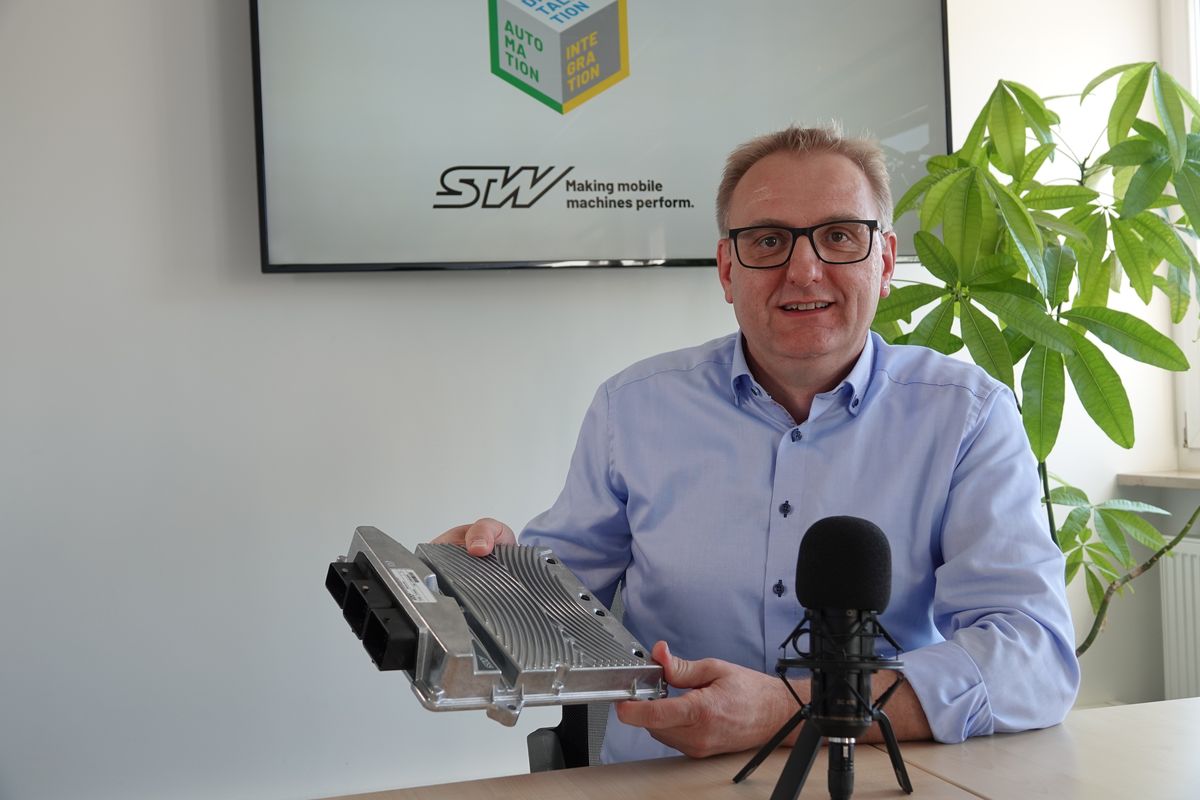Experts agree that the future in farming and construction lies in semi and fully autonomous vehicles and machines. STW, from Kaufbeuren, Germany, is ready for this development with the new ESX.4 control unit series. STW Director of Product Management, Christian Klausner, and Product Manager Control Units, Stefan Hohn, explain what advantages the new platform has to offer for developers of mobile machines.
Mr. Klausner, why is now the right time for a new series of control units?
Christian Klausner: The ESX.3 series had been successfully serving the market for more than 20 years. Developments in technology and market requirements have made a new family of controllers necessary. In particular, the assistance and support systems we typically see in the automotive sector are increasingly in demand for mobile machines. We have developed the ESX.4 series to meet the demand for increasingly intelligent, autonomous machines and subsystems.
What distinguishes the new control series, Mr. Hohn?
Stefan Hohn: We have based the entire control family on a common processor platform. With three 300 Mhz cores, the Aurix based platform is both powerful and certified for safety applications in accordance with SIL2/PLd. The control unit variants differ primarily in the number of inputs and outputs. This approach ensures that the machine developer does not have to compromise on the design, and oversizing is also not necessary. Providing the right control unit size for each individual application is an important goal for us. With the variants ESX.4cs-gw, ESX.4cm-a and ESX.4cl, three different control unit sizes are being introduced this year.
Regardless of the variant, all ESX.4 mobile controllers have, in addition to the usual CAN interfaces, at least one managed Ethernet switch with up to 1 Gbit transfer rate and BroadR-Reach interface. This relieves the main processor and provides the necessary performance for processing the ever-increasing amounts of data on the machine. An example of such a demanding application would be an intelligent camera system.
For which applications is the use of the new control series particularly advantageous?
Christian Klausner: We are not limited to any specific application. We cover all application complexities and machine sizes. If you want to implement a comparatively simple application with just a few actuators and sensors, you might choose the ESX.4cs-gw. If however you want to implement a highly automated application, as is often found in agricultural technology, you might build a system around the larger ESX.4cl. With a ESX.4cs-gw supported by further smaller controllers or IO nodes, there is also the possibility to realize a large decentralized vehicle architecture.
Stefan Hohn: We want to make it as easy as possible for the machine developer. The multicore platform offers the great advantage that non-safety and safety applications can be applied on different cores. This simplifies product maintenance enormously, since in the event of updates to the application core, re-certification of the entire system is not necessary. Further, our preparatory SIL2/PLd certification of the Aurix platform also reduces the initial engineering effort compared to other systems that that don’t offer this pre-certification. This also simplifies the implementation of customer-specific control solutions. With the support of the STW Academy and the training programs, customers can prepare themselves well for the integration of their control system.
The scalable approach of the controller family, with controllers that all share the same architecture and features, also enables applications to be transferred from one ESX.4 controller to the next without time-consuming adaptation, making integration and implementation of functionalities much easier. To assist with the implementation, we offer openSYDE, an open and user-friendly software environment that is of course compatible with the ESX.4 family.
Another advantage of the platform approach, especially at the moment with widespread supply chain disruptions, is that the long-term availability is significantly increased, and the number of individual components decreases.
You mentioned openSYDE, Mr. Hohn. What’s that about?
Stefan Hohn: openSYDE is our software suite for the implementation, commissioning and analysis of control systems. The software suite accompanies the entire product life cycle of the machine, from variable definition to system documentation and support. The complete system definition, configuration, maintenance and documentation can be managed centrally. openSYDE is very intuitive to use thanks to the drag-and-drop editor and predefined libraries. Since openSYDE is also already TÜV-certified up to SIL2/PLd, the software environment is the perfect solution for safety applications. In addition, unlike other comparable development environments, openSYDE is open source and therefore open to continuous improvements from the community. Third-party products can also be integrated into this framework, in particular the components and systems from our STW ECO system.
What is the STW ECO system?
Christian Klausner: The STW ECO system is the range of mutually compatible products and systems from our own portfolio and from our partner network. All components in the ECO system are optimally matched to each other to ensure maximum compatibility. The openness of the portfolio also enables easy integration of the products into third-party systems. Where necessary, the experts from our partner network also support us with appropriate technologies and components. So, with the help of the partner network, STW can act as a single-source support and service provider for the machine manufacturers. This facilitates coordination, consulting and engineering throughout the project.
What can we look forward to from STW in the future?
Stefan Hohn: We are of course constantly developing our controller portfolio further. We have recently developed the HPX controller, a high-performance platform specifically aimed at fully automated systems. With the HPX we are focusing on the rapidly increasing number of applications in mobile robotics. Our ESX.4 family will also be growing in the near future. We will soon be introducing a particularly small control unit, an XL variant, and also various industry-specific derivatives. We will also be expanding our complementary range of central electric modules. These additional products will enable us to satisfy an even wider range of wishes from machine manufacturers, with greater precision.
![[Translate to English:] [Translate to English:]](/fileadmin/_processed_/5/3/csm_Interview_CKL__f1104bb414.jpg)


![[Translate to English:] [Translate to English:]](/fileadmin/_processed_/f/4/csm_Logo_41f8d03cbf.jpg)